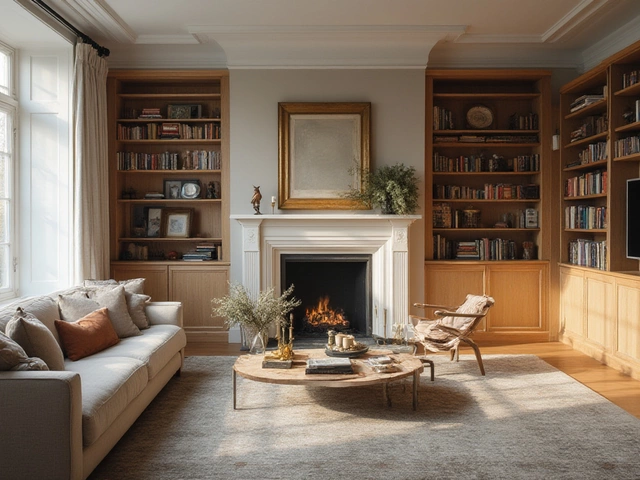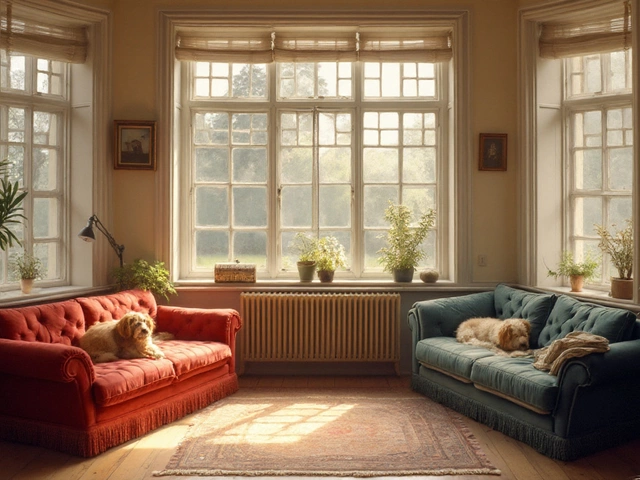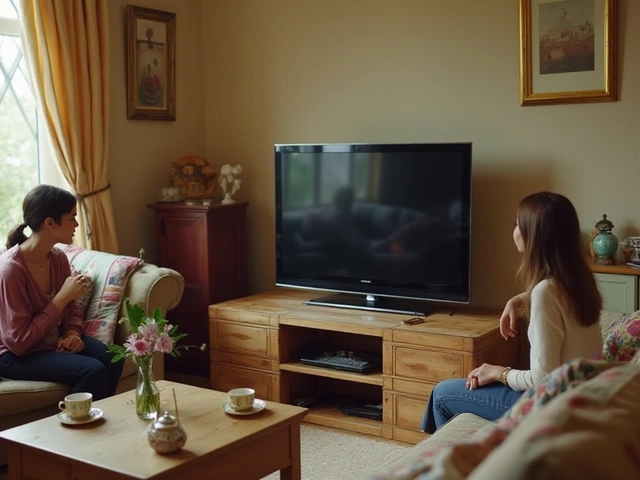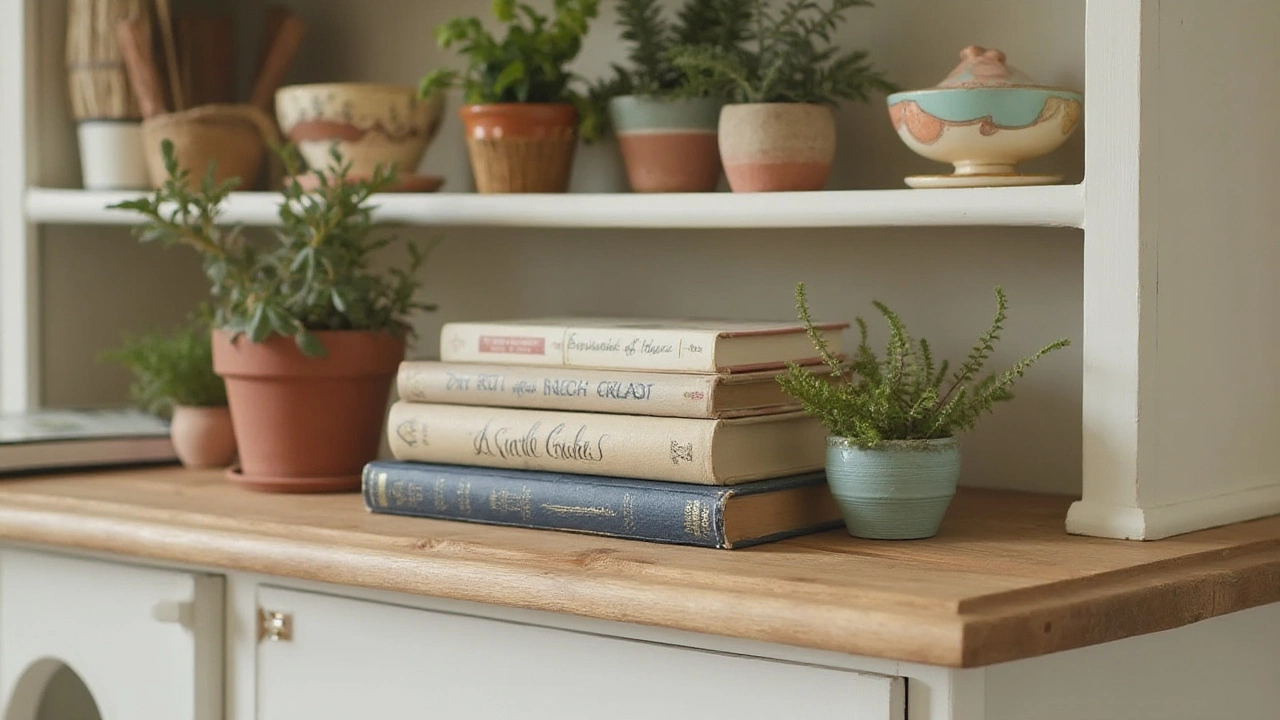 5
Jan,2025
5
Jan,2025
Have you ever looked at a beautifully styled shelf and wondered how it all comes together so effortlessly? Chances are, the decorator is harnessing the timeless principle of the rule of threes. This simple guideline is not just an architectural or arithmetic phenomenon; it's a trick that designers swear by, adding a splash of magic to any shelf setup.
At its core, the rule of threes is about creating balance with an odd number of items. When we see objects clustered in groups of three, it naturally appeals to our senses, evoking a sense of harmony and order. The tradition isn't just reserved for professional design – anyone can apply it to their home decor, especially shelves and bookcases.
Imagine a bookcase filled with carefully chosen objects that not only showcase your personality but also draw the eye to each segment as if telling its own little story. By using the rule of threes, you can transform any collection of books or knick-knacks into an engaging narrative. Let's dive into the art and science of this enchanting rule and how you can use it to your advantage.
- Understanding the Rule of Threes
- Historical Significance in Design
- Applying the Rule to Bookcases
- Tips for Effective Shelf Styling
- Common Mistakes and How to Avoid Them
Understanding the Rule of Threes
The rule of threes is one of those delightful nuggets of wisdom that pops up everywhere in life, especially when it comes to decorating and design. Its origins can be traced back to ancient times where civilizations recognized the mystical and mathematical significance of the number three. In art and music, we see it as a foundation—think of the structure of a basic triad in music or the composition of a triptych in visual arts. The idea is simple: our brains revel in pattern recognition, and odd numbers, particularly three, provide just enough ambiguity to be stimulating while still offering balance. In shelf styling, this rule suggests grouping objects in threes—three books, three plants, three decor pieces—which creates a visually appealing symmetry.
Designers have long championed this principle, from the ancient technique of the 'golden ratio' which often incorporates the number three, to modern-day applications in interior decorating. Why is the number three so effective, you ask? Well, it turns out our brains are hardwired to respond positively to odd numbers which provide a point of focus. An even number often appears too staged, lacking a dynamic focal point. Three, however, crafts a story, a journey that the eye naturally wants to follow. Let’s consider an interesting quote by the renowned designer Kimberly Merritt who said,
"Decorating with objects grouped in threes creates balance in a harmonious way, encouraging exploration without overwhelming the senses."This beautifully captures how powerful the rule of threes can be.
Applying this timeless technique to a bookcase isn’t just about tossing items onto a shelf and hoping for the best. No, it's a thoughtful process that combines color, texture, and material. The aim is to create a display that feels collected, intentional, and pleasing to the eye. One way to achieve this is by mixing different scales or shapes within your trio, perhaps a solid bookend with a tall, thin candle and a short stack of books. In doing so, you create layers and depth that make each individual item that much more intriguing. Remember, the goal is not symmetry but balance and intrigue. As you explore the rule of threes, it's interesting to note that some experts also suggest incorporating diverse heights or textures to make each group distinct yet cohesive.
To those unfamiliar with the art of decor, applying this technique might initially seem challenging, but the beauty lies in its simplicity. Perhaps the best approach is to experiment—try different combinations of objects and observe how the distribution affects the visual flow. Sometimes, introducing a pop of color or a personal artifact can make one of the three elements stand out, creating an anchor around which the other items revolve. It's a friendly reminder that there's always room for personalization, making the rule of threes not a rigid guideline but a playful framework to enhance your creativity.
Time and again, decorators emphasize how this rule brings harmony without the monotony of even-numbered items. In essence, the majestic charm of the rule of threes lies in its power to engage and invite curiosity, inviting us to look at our surroundings in an astonishingly fresh way. Next time you gaze upon those shelves, remember: three is not just a number—it's a key to crafting a more captivating space.
Historical Significance in Design
From ancient architecture to modern interior decor, the concept of the rule of threes has wielded its influence across time. Its origins can be traced back to the principles of geometry and balance seen in iconic structures such as the pyramids of Giza and the Parthenon in Athens. In ancient times, designers and architects revered the triadic grouping as a harmonious composition. This practice wasn't born from aesthetic alone; it was deeply tied to philosophical understandings of balance and unity. The belief that all good things come in threes is reflected not only in design but also in storytelling, music, and art throughout history.
Fast forward to the Renaissance era, renowned artists such as Leonardo da Vinci and Michelangelo applied the rule of threes in their work. Their masterpieces often incorporated triadic compositions, bringing a sense of structure and focus to their paintings. Da Vinci's 'The Last Supper' illustrates this perfectly: elements are grouped into threes, leading the viewer's eye through the painting in a balanced dance. Art historians suggest that the natural rhythm created by the triads aligns with the human perception of visual harmony, which these masters cleverly utilized to enhance their storytelling.
In the realm of architecture, the use of threes is conspicuous in classical orders such as Doric, Ionic, and Corinthian pillars. These structures exhibit a visual grace that has endured centuries, underscoring the saying that good design is timeless. The advent of the modernist movement saw figures like Le Corbusier and Frank Lloyd Wright extending these principles into new forms and materials. They experimented with modular designs, often integrating three primary elements to create functional spaces that are visually appealing.
"A space with the right balance feels as though it has a soul, as though it can breathe," mused Wright, highlighting the enduring interplay of form and function.
Today, the rule of threes remains a cornerstone of interior design, notably in shelf styling and decor. Decorators and home enthusiasts embrace this principle, recognizing its ability to transform any setting into an inviting and cohesive environment. This is especially true for bookcases, where the strategic placement of items like books, vases, and art pieces elevate a room's ambiance. As with any principle, the key lies in flexibility: a pair of books might sit beside a ceramic vase, accompanied by a framed photo to complete the triad, adding a personal touch that makes the arrangement resonate with the viewer.
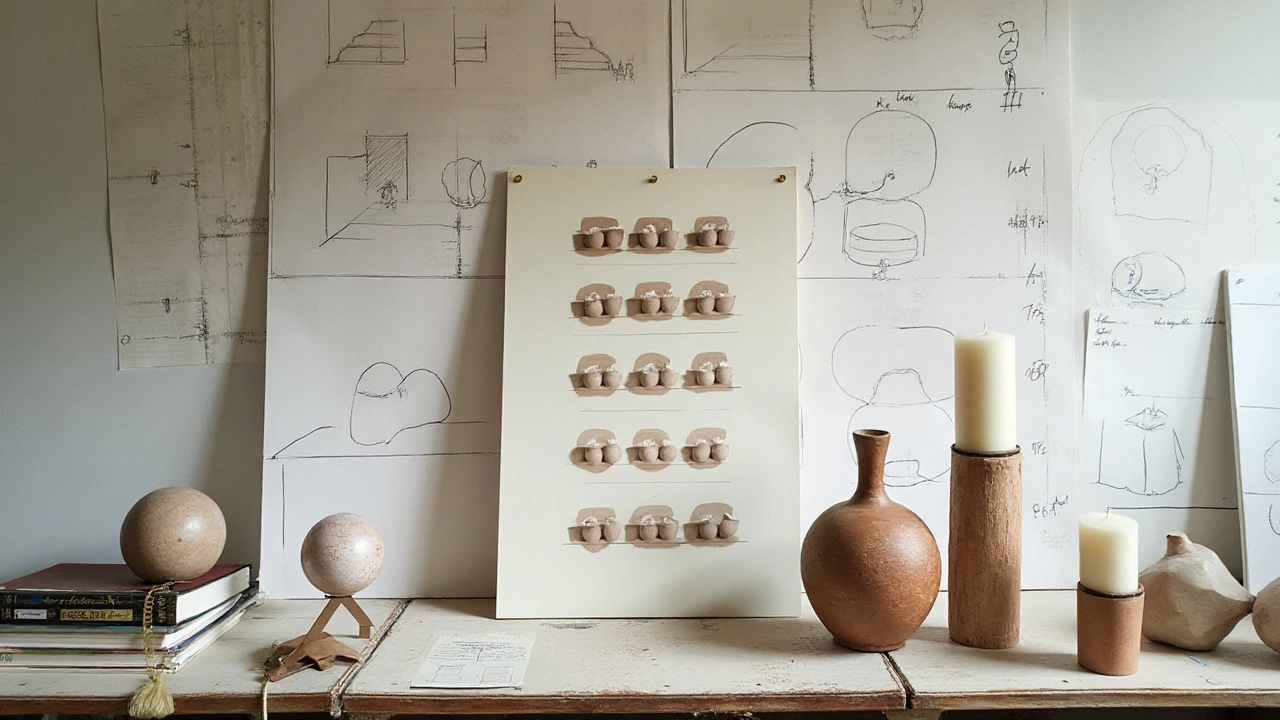
Applying the Rule to Bookcases
Transforming your bookcase from a mundane storage shelf to a stunning visual focal point can seem daunting at first. However, with the rule of threes, it’s like piecing together a beautiful tapestry. This magical number doesn't just work in decor, but it's deeply rooted in the psychology of perception. Our minds are naturally drawn to odd numbers, and three is just enough to create both interest and balance. So, when you’re curating your bookshelf, think beyond the books. It's about creating a story, a journey of exploration across each level.
Start by imagining your bookcase as a canvas. Divide each shelf into sections, and in each section, aim to place items in groups of three. It could be a trio of books, a sculpture, and a picture frame. The items need not be uniform or similar in size, which adds to the dynamics of the display. This variety in height, texture, and color is key to capturing attention and maintaining aesthetic balance. It's much like composing a piece of music where the notes differ, yet contribute to the harmony.
Consider the functionality of your bookcase. Are you storing mostly books, or is it a mix of books and decorative items? Books, of course, lend themselves naturally to the rule of threes simply by alternating vertical and horizontal piles. This not only breaks the monotony of lines but allows the eye to move effortlessly across the shelf. Add an ornament atop a stack of books for an additional layer of interest. A picture frame or a decorative bowl can compliment a row of vertical books, providing both utility and artistry.
The New York Times emphasizes, "The rule of three in design is more than just a guideline - it’s an invitation to imagination."
Let’s delve deeper into color coordination. While functionality is important, part of applying the rule lies in making these components visually appealing. Colors should flow harmoniously across the bookcase. Don't be afraid to use a pop of color to draw the eye. A red vase amid neutral tones can act as a captivating centerpiece. Texture is your ally here as well - pair smooth surfaces with rough or glossy with matte to keep the visual journey intriguing.
Lighting can also play a crucial role. If possible, integrate some lighting elements to highlight certain sections of your bookcase. Small LED lamps or a string of fairy lights can give your shelf an ethereal glow, emphasizing the beautiful shelf styling you've created. This creates a focal point in the room and enriches the overall ambiance. Proper lighting can also delicately emphasize the intricate elements that might otherwise go unnoticed.
Lastly, keep evolving your decor tips. As you collect new items, or as seasons change, update your displays to keep them fresh and exciting. A bookcase is not a static piece of furniture; it’s an evolving art form. And as you grow, learn, and change, so should your bookcase. Embrace the journey of transformation, letting the rule of threes be your guiding star in creating an inviting and beautifully balanced space.
Tips for Effective Shelf Styling
Styling shelves can often feel like a daunting task, but with a few strategic techniques, anyone can create a stunningly styled shelf that catches the eye and captivates the imagination. The first tip is to consider the balance between functionality and aesthetics. Shelves, especially bookcases, are not only for showcasing decor but also for storing items. Prioritize what you want to display and ensure it serves a purpose, either practical or visual. Incorporate a mixture of books and decorative items, playing with color and size to achieve a harmonious look.
Another essential tip is to vary the heights and textures of the objects you place on your shelves. This variety creates visual interest and prevents the arrangement from appearing too uniform or boring. Consider including items like vases, picture frames, and unique trinkets. Group these items in sets of three or five, using the rule of threes to guide your placement. This odd-numbered grouping can provide a more dynamic and pleasing setup. Don't shy away from layering; stacking books or adding a small sculpture on top of stacked items can add depth to the look.
It's also important to focus on color coordination when styling your shelves. Decide on a primary color palette and use it consistently throughout your display. This could mean choosing items within a similar hue, or if you're more adventurous, contrasting colors to make specific elements pop. A thoughtful interplay of colors can make your shelf decor not just complementary to the room, but a vibrant focal point. Be aware of the overall mood and feel you wish to evoke in your space. For a cohesive theme, the tones should echo the room's decor, whether it's minimalist, rustic, or eclectic.
An often overlooked aspect is the use of negative space. Shelves do not need to be crowded; leaving space around items can let each piece breathe and stand out individually. This technique can be especially effective when you have a statement piece that you want to highlight. Get comfortable with rearranging items until you find the right fit. It might take several attempts, but the process itself encourages creativity and experimentation. As renowned interior designer Nate Berkus once said,
"Your home should tell the story of who you are, and be a collection of what you love."This principle can guide your choices as you personalize your shelves.
To illustrate some common techniques, here’s a simple table of essential styling elements you might find useful:
| Element | Purpose |
|---|---|
| Books | Foundation and Color Base |
| Vases | Height and Shape Variation |
| Artwork | Focal Points and Personality |
| Plants | Natural Aesthetic and Texture |
| Photo Frames | Personal Touch and Depth |
Lastly, remember that while there are many guidelines, there are no strict rules when it comes to creativity. Your shelves should be a reflection of your personality and interests. Rotate your displayed items periodically to freshen up the look and keep the space dynamic. By following these tips, you'll find that styling your bookcases becomes not only manageable but also a delightful and rewarding experience. Enjoy the process and watch as your space comes to life.
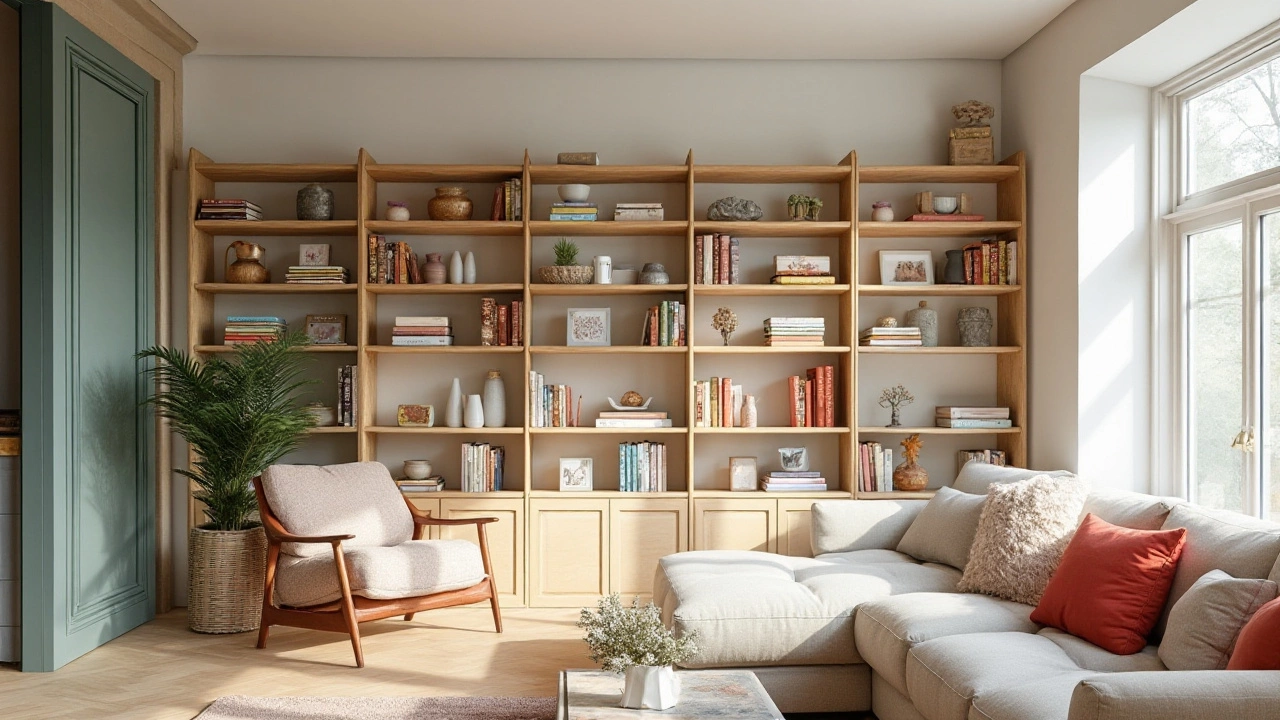
Common Mistakes and How to Avoid Them
Styling shelves might look like an easy task, but many people stumble when trying to apply the rule of threes. One common mistake is overcrowding. It's tempting to keep adding items until every nook and cranny is filled, but doing so can lead to a cluttered and overwhelming look. Instead, embrace negative space; it helps highlight each item's unique attributes and gives the eyes a place to rest. Consider the visual weight of your objects. For instance, mixing books with decor pieces can create a dynamic flow, but ensure the sizes vary enough to maintain interest without becoming monotonous.
Another frequent error is neglecting coherence. Although variety is vital in shelf design, it shouldn't come at the cost of a unified theme. Pieces should complement each other, not only in color but also in style and texture. Visual harmony is imperative. An assortment of vintage items next to sleek modern artifacts might seem appealing at first glance, yet can clash if not carefully orchestrated. Before you begin, choose a theme or color scheme to guide your selections. This will make the grouping more cohesive and engaging to look at. Remember to stand back periodically and assess your work from a distance; it’s easier to spot inconsistencies this way.
Height and depth varieties are often overlooked, which can flatten the visual interest of your shelf styling. Each section of your bookcases should have pieces at different levels. Stacking books horizontally and placing a small plant or sculpture on top can add depth, while using frames of distinct sizes can break up monotonous lines. Implementing varying heights keeps the eye moving across the display, preventing the shelf from becoming static or boring. Don't be afraid to experiment with depth as well; stagger items so they don't all sit flush with the edge of the shelf.
A mistake that flies under the radar is poor lighting. No matter how beautifully styled your shelf, if it's hidden in shadows, its charm is lost. Position your bookcase in a well-lit room or consider installing small lights above or within each section to give each piece its moment in the spotlight. Reflective surfaces, such as mirrors or glass figurines, can also help bounce more light around and brighten your overall setup. Proper lighting can make your carefully arranged objects gleam and glisten, which adds a layer of sophistication and allure.
Following rules rigidly can sometimes stifle creativity. The rule of threes is a guideline, not a straitjacket. Experimentation should always be part of the process. As famed graphic designer Paul Rand once said,
“Design is the silent ambassador of your brand.”Your shelves should speak of your personality and style. Occasionally breaking the rule with a carefully chosen exception can enhance overall impact, bringing a fresh twist to your display that catches the eye and tells a deeper story. Embrace trial and error; your shelves are a canvas awaiting your unique touch.
